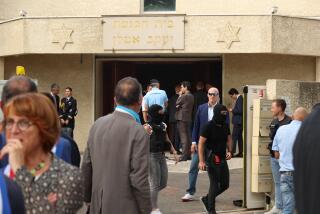Florida Arsonist Targets Churches : Crime: Thirty structures have been hit this year. Task force hunts suspect as congregations take precautions.
- Share via
OCALA, Fla. — From the front steps of the First Presbyterian Church, the Rev. Ray Ruark need only look about 40 yards to the east to find a stark reminder of the danger haunting this part of Florida. The charred bricks and cinders that cover the lot next door are all that remain of the First Baptist Church’s sanctuary, a four-story, red-brick structure that dominated this town’s historic residential neighborhood for 65 years.
“There’s a great worry we could be next,” said Ruark, senior pastor of First Presbyterian.
Indeed, as an outbreak of arson continues to rage throughout north-central Florida, no church seems safe. This year 30 houses of worship have been burned--some of them destroyed, most severely damaged. “This is an epidemic,” said Florida Gov. Lawton Chiles.
To crack what has grown into the biggest arson mystery in the United States, the best fire investigators in the country have been sent to Florida to staff a special task force put together by the federal Bureau of Alcohol, Tobacco and Firearms and the Florida fire marshal. A $25,000 reward for information leading to the arrest of the person responsible has been offered.
Last week local newspapers reported that a 41-year-old man jailed on trespassing charges had been under surveillance by the task force. He has not been charged with arson.
In a press conference, state fire marshal Tom Gallagher said: “I don’t believe there was one person setting these fires. Maybe there are one or two people doing the fires and we ended up with a lot of copycats.”
Investigators admit the case is baffling. “We have no suspects in custody, although we have some suspects we are investigating,” said Bruce Snyder, an ATF agent and task force spokesman. “We have more than 650 leads we’re following up on, and a large manpower commitment. Frankly, we feel very confident we are going to solve this with an arrest of person or persons responsible. I just don’t know when.”
Clearly, churches are the arsonist’s targets. But beyond that a pattern is hard to discern. “It’s not denomination, race, stand on abortion; it’s real random,” said the Rev. Phillip Hanes, associate pastor of the First Baptist Church, consumed by flames early on the morning Oct. 24. Loss was estimated at $4 million.
“At times like this there is a tendency to ask, ‘What did I do?’ ” Hanes said. “But I don’t think there is any answer. We were just in the wrong place at the wrong time.”
Since Jan. 21, 30 church fires--most of them suspicious in origin--have been reported in a broad area defined by Interstate 75, which runs through the center of the state, and Interstate 95, which parallels the east coast. The cities of Ocala and Gainesville, 35 miles apart, have been particularly hard hit.
But investigators are also looking at church arson attacks that extend beyond those boundaries of geography and time. Beginning with an April, 1990, fire in a Baptist church near Ft. Myers, on Florida’s west coast, the number of suspected arsons reported statewide jumped to more than 50.
The task force has released little information about fire scene clues, if any, or telltale patterns they may have uncovered, on the chance that the arsonist ultimately may be identified with information only he knows. And there may be more than one arsonist; copy-cat fires are also possible, officials say.
The FBI has developed a psychological profile of the arsonist, Snyder says, but he won’t discuss it. However, an expert in serial arson suggests that the culprit is likely to be a man, possibly someone whose job requires traveling the state, who is targeting churches for motives of revenge.
“Churches are symbolic,” says Dian Williams, a psychiatric nurse in Philadelphia who heads the Center for Arson Research, “and perhaps what we’re seeing here is someone who offered a prayer, for the life of a child, let’s say, and then that child died. For whatever reasons, burning churches serves a purpose, of relief or revenge.”
Williams, who has consulted with federal authorities on several arson investigations, is not officially involved with the Florida fires. But from what she knows of the outbreak, she says, “It is clear that the arsonist has been careful not to cause loss of life.” All of the fires have been set at night, when the churches were unoccupied. At the same time, Williams says, the increasing frequency of the blazes “is very frightening.”
Parishioners at those churches still standing, meanwhile, are raising money for security measures once thought unnecessary. At the First Presbyterian Church here, where an arsonist apparently tried to start a fire but failed the same night the First Baptist Church was torched, extra lights and nighttime security guards are now in place, Ruark says. “And we’re getting bids on a fire alarm system,” he adds.
For several weeks some area churches allowed volunteers from the congregation to spend the night in their churches as a way of protecting them. But police agencies discouraged that.
What is encouraged is prayer. “I’ve been asked if I harbor any resentment toward this person,” Ruark said. “ ‘Would we like to get ahold of the guy?’ We’ve made a commitment as a church to pray for that person. There must be some real frustration there. But God still loves these folks. It’s just very sad.”
More to Read
Sign up for Essential California
The most important California stories and recommendations in your inbox every morning.
You may occasionally receive promotional content from the Los Angeles Times.













